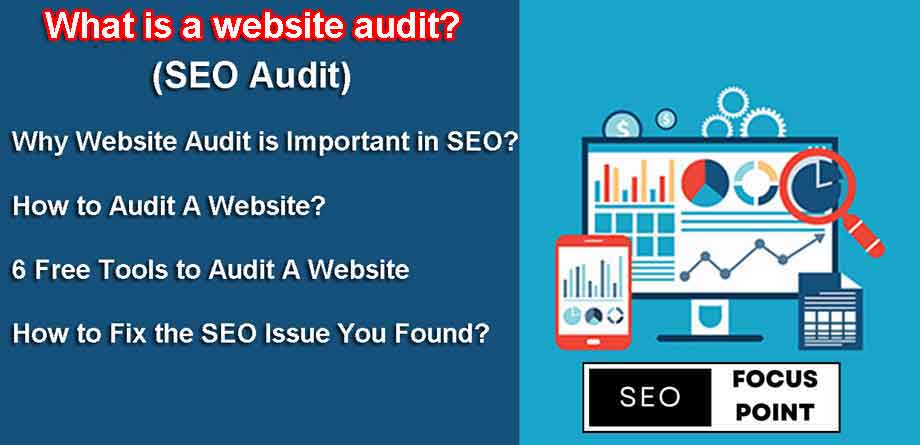In this article, you will get the answer What is a website audit? (SEO Audit). You will Learn Why website audit is Important for Technical SEO. You will also learn How to Audit Your website for free & How to fix the detected issue. Let’s start with our focus.
Table of Contents
Table of Contents
What is a website audit?
A website audit is a comprehensive analysis of a website’s performance, user experience, and search engine optimization (SEO) factors. It involves evaluating various aspects of the website such as website structure, content quality, user engagement, website speed, mobile-friendliness, and more.
The main goal of a website audit is to identify areas of improvement and provide recommendations for optimizing the website to improve its overall performance. A website audit can be conducted by an individual or a team of experts, including web developers, SEO specialists, and digital marketers.
The audit process typically involves using various tools and techniques to analyze the website’s data and generate a report that highlights areas that require attention. The report can include recommendations for improving website structure, optimizing content, enhancing user experience, and implementing technical SEO best practices.
Why Website Audit is Important in SEO?
We Already Know What is a website audit? or SEO Audit. Now we will focus on why Website Audit is Important in SEO. We Conduct SEO Audits to bring a Good Domain Authority. A website audit can provide valuable insights into how well a website is performing, and it can identify areas for improvement. Here are some reasons why a website audit is important:

- Improving User Experience: A website audit can identify issues that affect the user experience, such as slow loading speed, broken links, or poor navigation. By addressing these issues, you can improve the user experience, which can lead to increased engagement, higher conversions, and improved customer satisfaction.
- Boosting Search Engine Rankings: Search engines like Google use complex algorithms to determine the relevance and quality of a website. A website audit can help identify issues that may be hindering your website’s visibility and rankings in search results. By fixing these issues, you can improve your website’s search engine optimization (SEO), which can help increase traffic and conversions.
- Identifying Security Vulnerabilities: A website audit can identify security vulnerabilities that may put your website and users at risk. This includes issues such as outdated software, weak passwords, or unprotected data. By addressing these vulnerabilities, you can improve the security of your website and protect sensitive user information.
- Improving Website Performance: A website audit can identify issues that may be affecting your website’s performance, such as slow page load times or high bounce rates. By optimizing your website’s performance, you can improve user engagement, increase conversions, and enhance the overall user experience.
- Enhancing Content Quality: A website audit can help identify issues with your website’s content, such as duplicate content, low-quality content, or outdated information. By addressing these issues, you can improve the relevance and quality of your content, which can lead to increased user engagement, improved search engine rankings, and higher conversions.
How to Audit A Website?
Do we have a clear understanding of What is a website audit? and Why it is important in SEO. Now the Question is How will I audit my website? Auditing a website involves analyzing various aspects of the website, including its technical structure, content, usability, and search engine optimization. Here are the steps to perform a website audit:
- Set Goals: The first step in auditing a website is to define your goals. Identify what you want to achieve with your website audit and what areas you want to focus on. For example, if you want to improve website performance, you may want to focus on analyzing website speed, user engagement metrics, and other performance indicators.
- Analyze Technical SEO: Analyzing technical SEO involves looking at the backend of the website to identify technical issues that can affect search engine rankings. Some of the areas to analyze include website structure, page speed, mobile responsiveness, website security, and structured data.
- Evaluate On-page SEO: On-page SEO involves analyzing the content on each page of the website to ensure it is optimized for search engines. This includes analyzing page titles, meta descriptions, header tags, image alt tags, keyword usage, and content quality.
- Check Website Usability: Website usability refers to how easy it is for users to navigate and interact with the website. Analyzing website usability involves evaluating website layout, navigation, call-to-actions, forms, and user engagement metrics.
- Review Content Quality: Reviewing content quality involves analyzing the content on the website to ensure it is informative, engaging, and relevant to the target audience. This includes analyzing the tone, readability, formatting, and multimedia usage.
- Analyze Analytics: Analyzing analytics involves looking at website traffic data to identify patterns and trends in user behavior. This includes analyzing traffic sources, user demographics, page views, bounce rates, and conversion rates.
- Create an Action Plan: After analyzing all the aspects of the website, create an action plan to address the identified issues. Prioritize the most critical issues and create a timeline for implementing the changes.
6 Free Tools to Audit A Website
There are several free website audit tools available that can help you analyze various aspects of your website. Here are some popular free website audit tools:
- Google Search Console: Google Search Console is a free tool provided by Google that helps website owners monitor and maintain their website’s presence in Google search results. It provides valuable insights into website traffic, search engine visibility, and technical issues.

- Google PageSpeed Insights: Google PageSpeed Insights analyzes website speed and provides suggestions for improving page load time. It also provides a score for desktop and mobile performance.

- GTmetrix: GTmetrix is a free tool that analyzes website speed and provides suggestions for improving performance. It provides a detailed report that includes page load time, page size, and the number of requests.
- SEMrush: SEMrush offers a free website audit tool that provides a comprehensive report on website health, technical SEO issues, and on-page SEO analysis. It also offers a backlink analysis tool that provides insights into backlink quality and quantity.

- Moz: Moz offers a free website audit tool that provides insights into website health, crawl ability issues, and on-page SEO analysis. It also provides a keyword research tool that helps you identify relevant keywords to target for your website.
- Ahrefs Webmaster Tools: Ahrefs Webmaster Tools is a free tool that helps website owners monitor website performance, backlink profiles, and crawl errors. It also provides keyword research insights and content analysis features.
How to Fix the SEO Issue You Found?
There are several common SEO audit findings that website owners and SEO professionals come across. Here are a few common issues and how to fix them:
- Broken Links: Broken links can hurt your website’s user experience and also affect your website’s SEO performance. To fix this issue, you can use online tools to identify broken links and replace them with working ones.
- Missing Meta Descriptions: Meta descriptions provide a summary of a web page’s content and help search engines understand the page’s topic. If a web page doesn’t have a meta description, search engines may use random content from the page, which can negatively impact the page’s SEO performance. To fix this issue, you can add unique meta descriptions to each web page.
- Duplicate Content: Duplicate content can confuse search engines and make it difficult for them to determine which version of the content to rank. To fix this issue, you can use canonical tags or 301 redirects to indicate the preferred version of the content.
- Slow Page Speed: A slow-loading website can hurt user experience and lead to a high bounce rate. To fix this issue, you can optimize images, minify CSS and JavaScript files, and use a content delivery network (CDN).
- Mobile Responsiveness: As more and more people are using their mobile devices to access the internet, it’s essential to have a website that’s optimized for mobile devices. To fix this issue, you can use a responsive design or create a separate mobile version of your website.
- Low-Quality Content: Low-quality content can hurt your website’s SEO performance and user experience. To fix this issue, you can create high-quality, informative content that’s relevant to your target audience.
In conclusion, I hope from this article you got the answer What is a website audit? or SEO Audit. It will help you to identify issues that could be negatively impacting your online presence and provides actionable insights for improvement. From technical SEO to user experience, a website audit covers all aspects of a website, allowing businesses to optimize their site for better performance and increased traffic. By conducting regular website audits, businesses can stay ahead of the competition and ensure their online presence is delivering the best possible results. In today’s digital age, a website audit is an essential tool for any business looking to succeed online.


2 thoughts on “What is a website audit?(SEO Audit)”